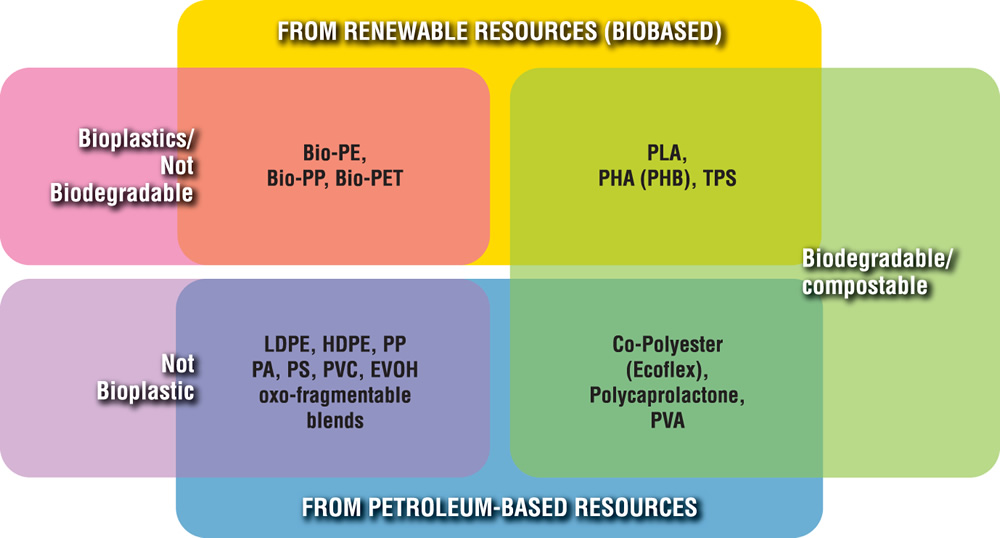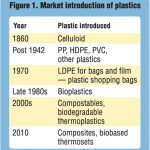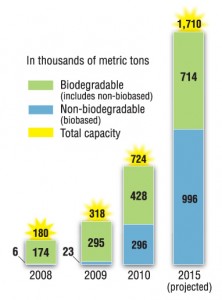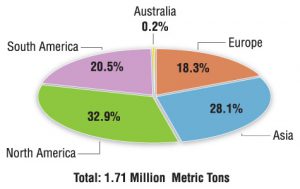The compostables sector of the bioplastics industry has been making significant inroads, especially with starch-based and PLA resins. Part I
Debra Darby
BioCycle August 2012, Vol. 53, No. 8, p. 40
The “plastics” industry in the U.S. dates back to the late 1860s, when Celluloid — an entirely new material made from a mix of cellulose nitrate and camphor — was introduced. Although flam-mable, celluloid moved into many markets including billiard balls and photographic film. After World War II, Phillips Petroleum Company expanded its product line with natural gas, setting the stage for plastics. It began research on the conversion of ethylene and propylene gases, which ultimately led to the discovery and transformation of hydrocarbons into plastics, according to the American Chemical Society. By the late 1970s, linear low density polyethylene (LLDPE) was introduced. Consumer market applications included plastic bags and thin films. Today the traditional plastics industry is a well-oiled machine with a mature global supply chain. Consumer use of plastics is a routine part of daily life.
Bioplastics — a family of materials that are biobased, biodegradable, or both — made their debut in the late 1980s. Like early plastics, bioplastics can have different properties ranging from flexible to rigid and can be used for a wide variety of disposable applications, or semidurable and durable products. Biobased plastics are being used in fibers, and in automotive, electronics, toys and sporting goods products (among others), replacing traditional materials including poly- propylene (PP), high density polyethylene (HDPE), and acrylonitrile butadiene styrene (ABS). Figure 1 summarizes the market evolution of plastics since 1860.
Actual biodegradability is based on a bioplastics chemical structure, not the raw resource used. Therefore plastics that biodegrade can be made from either petroleum-based or renewable-biobased resources. And nonbiodegradable plastics can be made from renewable resources. Figure 2 illustrates these various distinctions, as well as whether bioplastic materials are structured to actually biodegrade. Biodegradables can be used for agricultural films replacing conventional LLDPE films and for horticultural applications like plant pots, trays and plant tags replacing conventional PP.
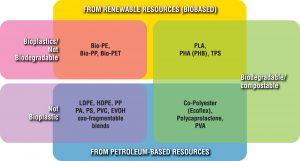
Figure 2. Bioplastics classifications according to biobased content and biodegradability (Source: bioplastics Magazine)
Specific bioplastic materials are biodegradable in specific environments, e.g., water, composting and anaerobic digestion. Bioplastic materials need to be independently third-party tested and certified for biodegradability — both in the specific environment and for the amount of time actually needed to biodegrade in that environment. Compostability of a bioplastic is defined as biological degradation under industrial composting conditions defined by ASTM D6400/EN 13432 standard specifications for compostable plastics, and ASTM 6868 standard specification for plastics as coatings typically used for paper. ASTM 7081 is a standard for biodegradability in marine water environments.
Industry Overview
The state of the bioplastics industry, and in particular compostables, can be tracked by looking at the various markets and applications typically dominated by earlier traditional plastic. Growth in consumer-driven markets, including packaging films, bags and food service disposables, are important signals for the bioplastics industry as compostables are becoming more commonly used for packaging, food service and catering.
Population growth and density in urban areas are driving legislation for compostable bags and implementation of residential or commercial organics recycling, as well as banning restrictions on single use plastics bags. As recent as May 2012, the City of Los Angeles became the largest city in the nation to approve a ban on plastic bags at supermarket checkouts.
The European Bioplastics Association reported global production of bioplastics reached 725,000 metric tons in 2010 and is expected to reach 1.7 million metric tons by 2015 (Figure 3). In 2010, North American bioplastics production reached 193,575 metric tons, according to European Bioplastics. “Today the bioplastics industry represents less than one percent of global plastics production,” says Melissa Hockstad, Director of the SPI Bioplastics Council. “It’s fast paced and growing with anticipated growth to reach over 20 percent per year through 2015.” Looking at the 2010 global bioplastics production figures, North America was 26.7 percent of the total global bioplastics production capacity. Hockstad adds that by 2015, North America should grow to 33 percent (Figure 4).
The Freedonia Group reported similar statistics in its World Bioplastics Report released in November 2011. It notes that demand for bioplastics in North America will grow to about 267,000 tons in 2015. Biodegradable plastics accounted for nearly 90 percent of the global bioplastics market in 2010. BCC Research reported the global biodegradables market reached 932 million pounds in 2011 and is expected to increase at a 22.5 percent compound annual growth rate to reach nearly 2.6 billion pounds in 2016.
Growth In Compostables
According to Freedonia, biodegradable/compostable starch-based resins and PLA have captured nearly 80 percent of the market and biodegradable/ compostable polyester resins accounted for 9 percent in 2010 (Figure 5). Figure 6 shows world bioplastics market demand by product sectors in 2010. Compostable bags (currently about 40%) should triple in demand due to pending regulations and expansion of the composting infrastructure, although there will be competition from paper bags and reusable cloth or durable plastic bags in major markets. Another area of growth is in food service disposables (currently 22.5%), which are projected to nearly double demand for compostable resins. Lower bioplastic costs and product availability, growth in the composting infrastructure and consumer awareness will help drive demand for this product sector. (Industry analysts tend to use the terms biodegradable and compostable as interchangeable in market reports, often confusing people outside of the industry, especially consumers. Part 2 of this article series addresses the terminology issue, including the Federal Trade Commission’s definitions.)
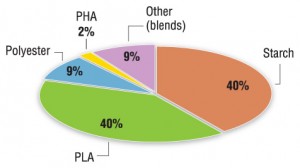
Figure 5.World biodegradables demand by resin type (estimated percentages) (Source: Freedonia World Bioplastics Report 2011)
Nearly 40 percent of the global maize (field corn) production is grown in the U.S. Sugar (dextrose) from field corn is used for many industrial purposes and is the primary feedstock for production of bioplastics. The large-volume feedstock users are Ingeo polylactic acid (PLA) from NatureWorks (Cargill) and MaterBi starch-based resins from Novamont, and to a certain extent Telles’ Mirel polyhydroxyalkanoate (PHA). (The joint venture between Metabolix and ADM was terminated in January 2012 but Metabolix plans to continue manufacturing biopolymers.)
NatureWorks is looking to diversify its raw ingredients for production, particularly sugar. Other plant-based sources of sugar, including sugar beets, sugar cane, cassava or wheat, can be used as a feedstock. NatureWorks will also consider making its Ingeo material from cellulosic raw materials, agricultural wastes and nonfood plants, says Steve Davies, director of corporate communication and public affairs with NatureWorks. According to Davies, NatureWorks’ principal markets are packaging, durable products, food service ware, textiles for clothing and soft goods, and personal care items such as wipes. Its areas of growth are in packaging and food service followed by durable goods and nonwoven fibers for wipes, diapers and filters.
From its founding in 1989, Novamont wanted to integrate agriculture, chemistry and functionality (like compostability or new chemical/physical properties) of its Mater-Bi polymers into a wide range of industrial applications, including collection of organics separated from municipal solid waste and intended for composting (kitchen waste bags, shopping bags), agricultural use (mulch films and various other devices), packaging, catering, cling films and produce bags. These applications present opportunities for bioplastics to help reduce contamination of organic waste for the composting stream. Vegetable oils, starch, cellulose and lignocelluloses can be used as ingredients for Novamont’s production process.
BASF has been producing bio-degradable copolyester ecoflex(®) polymers that are currently used in compostable trash bags and single-use disposable packaging. During manufacturing, Ecoflex can be used similarly to LDPE for production of films, bags or coatings, and can be blended with thermoplastic starch and other biodegradable polymers. BASF’s ecovio® is a blend of ecoflex and PLA (polylactic acid) for compostable catering items like tableware and clamshells.
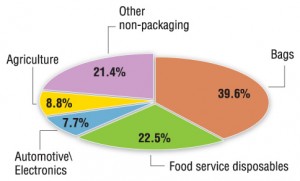
Figure 6. World bioplastics by market demand (estimated percentages) (Source: Freedonia World Bioplastics Report 2011)
There is a burst — and an evolution — of new bioplastics companies and production facilities offering a wide range of new materials that have market potential. A few of these new market entries will offer compostables, including DaniMer Scientific and Meridian, sister companies retro-fitting an existing production plant in Bainbridge, Georgia for a pilot operation to produce 30 million pounds/year of PHA. Ecospan’s BioFlow™ is a proprietary biopolymer, blended with other petroleum-free ingredients or with petroleum-based ingredients for a variety of products and packaging. Ecospan works with clients from the outset, starting with application development and implementation of an end-of-life reuse and regrind strategy in a closed loop model that keeps material resources in the value chain and out of landfills. A new company, Laurel BioComposite LLC, is manufacturing and marketing a biobased product to replace a portion of traditional plastic resins like HDPE in a variety of applications.
Nonbiodegradable Resins
Since 2010, biobased polyethylene (bio-PE) has gained rapid market acceptance and is produced in large volume. This growth is expected to fuel biobased versions of PP, polyvinyl chloride (PVC) and partial biobased polyethylene terephthalate (PET). These are not biodegradable bioplastics, however they are made from renewable resources, primarily sugar cane. They will be considered drop-in replacements for petroleum-based plastics, as the products are identical in their chemical structure and physical properties. These materials help brand owners increase their use of biobased content to support marketing objectives. Products made from bio-PE must be recycled, landfilled or incinerated like their traditional plastics counterparts. Therefore before going to market, brand owners and distributors should have any new packaging material or packaging design tested at materials recovery facilities (MRFs) for recyclability in existing systems.
Braskem’s biobased polyethylene plant in Brazil uses sugar cane as the feedstock, as will Dow Chemical’s plant that is expected to open in Brazil by 2014. Several key market segments have demonstrated the value of bio-PE including consumer packaging manufacturers Procter & Gamble, Swedish food packaging company Tetra Pak and Japanese cosmetics company Shiseido. Future production of commodity plastics such as PP, PVC and PET from biobased sources, particularly in Brazil, is also very likely to use sugar crops. Freedonia reports that global production of sugar cane and sugar beets will increase more than two percent annually to reach 2.2 billion metric tons in 2015.
Partnerships Align Supply Chain
In June, Coca-Cola, Ford Motor Company, H.J. Heinz Company, NIKE, Inc. and Procter & Gamble announced formation of the Plant PET Technology Collaborative (PTC). These big brands will work together on development to support plant-based PET — bio-PET that has the same chemical structure as petroleum-based PET and is manufactured like PET. For these large consumer brand owners that already have major products intended for the recycling stream, bio-PET is important to their existing operations and their corporate sustainability initiatives. Biobased PET is recyclable along with conventional PET. Bottles made from bio-PET can be recycled through MRFs, making it an easy drop-in replacement for brand owners to adopt for existing consumer product lines.
One big splash is the PlantBottle packaging technology, the first recyclable bio-PET plastic beverage bottle manufactured with up to 30 percent biobased PET made from sugar cane. The Coca-Cola Company markets the PlantBottle as partially made from plants with a lower environmental impact when compared to traditional PET bottles. Heinz is now licensing the technology from Coca-Cola. PepsiCo is working on a plant-based bottle using biomass feedstocks such as switchgrass, pine bark and corn husks. It is focused on pilot production of the new bottle in 2012, with plans for full-scale commercialization. Pepsi’s goal is to broaden the feedstock resources to include orange peels, potato peels, oat hulls and other agricultural byproducts from its food business.
Industry stakeholders are working together with resin manufacturers, converters and distributors to align the supply chain. This mutual undertaking will enable a better understanding of the packaging needs that can translate over to engineering bioplastic material properties around those needs. The key is to design with end-of-product life strategies early in the process and to use clear marketing claims about the proper end-of-life for the packaging.
Product Attempts
The SunChips 100 percent compostable bag made with Ingeo biopolymer was a packaging achievement. The bag was designed to fully compost in about 14 weeks in a hot, active composting pile. What from the outside appeared as a simple snack bag, was a complex multilayer structure that required barrier properties to keep moisture and oxygen out. As part of its sustainability endeavors, Frito-Lay worked on a long development schedule to implement use of plant-based renewable materials. This was a huge and important risk. The SunChips bag ran up against a consumer issue — noise caused by stiff material in a multilayer design. But the noise was overcome with a change to adhesives used between the two-layers of the bag. The SunChips bag was a learning experience and an opportunity to make modifications. But it illustrates the unexpected difficulties of new product development and market acceptance.
These types of packaging trials and experiments are needed to grow market acceptance of compostable packaging. The industry is collaborating to solve packaging problems. Consumer packaged goods companies now have a knowledge base and understanding of bioplastics, which is raising the level of market acceptance into main stream use. For example, Target incorporated Ingeo biopolymer in film bags for its in-house Archer Farms brand of snack chips. The chip bag represents the latest generation of flexible multilayered packaging.
Making Inroads
Composting and compostable products have made inroads primarily in the institutional and commercial sectors in the U.S The food service and catering sector is a significant market force with measurable factors that will shape bioplastics production development over the next several years. The greatest impact is on the supply side among resin producers, distributors and others in the compostable bioplastics industry. A greater number of converters are beginning to work with compostable polymers. Distributors of food service packaging now have full lines of compostable items available in greater quantity and diversity to supply the increasing food waste recycling and zero waste programs.
“As food scraps diversion continues to grow, opportunities have become more evident to suppliers who were not early adopters,” says Steve Mojo, executive director of the Biodegradable Products Institute (BPI). “More companies are participating in this market. Also, BPI continues to see improvements in properties and processing, which help to improve performance and in some cases lower costs. As more diversion programs are created, composters are realizing that compostable food service items are one of the keys to collecting and processing more food scraps.” Mojo adds that the next wave of food scraps diversion will be driven by residential collection, where consumers are actively involved in the process.
With food diversion programs positioned for growth, manufacturers are adding capacity to meet the expected demand from the institutional market, especially compostable food service items and can liners. Manufacturers are increasing the level of production to ensure that availability of compostable products matches the market demand. For example, BASF has increased production of ecoflex fourfold since 2010 and continues to increase ecovio as needed.
Part II of the “Bioplastics Industry Report” will address marketing claims and how compostables are being marketed for composting. It also will review recent developments in refining industry standards for compostability to reflect variations in composting processes and technologies.
Debra Darby is an independent marketing consultant with a background in bioplastics marketing.
Sources Cited
European Bioplastics
Freedonia World Bioplastics Report 2011; www.freedoniagroup.com
BCC Research www.bccresearch.com/report/biodegradable-polymers-market-pls025d.html
BASF www.basf.com/group/corporate/en/brand/ECOFLEX
ICIS www.icis.com/Articles/2011/02/28/9438198/dow-studies-bio-based-propylene-routes.html


